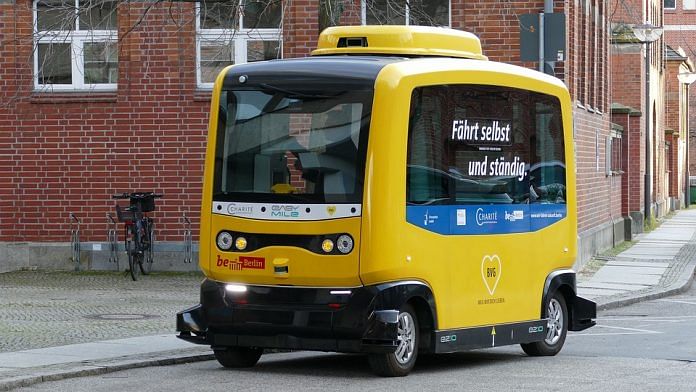Autonomous vehicles (AVs) hold great promise for the future of mobility, with the potential to deliver a safer, cleaner, more efficient and more inclusive transportation ecosystem.
Meanwhile, policy-makers are trying to navigate the trade-offs between enabling testing and trials of AVs, to protect their citizens from the unnecessary risks created by unproven technologies.
The World Economic Forum recently spoke to regulators from around the world to understand how they’re navigating the tensions that emerge during safe and effective AV policy development. Here are three key lessons they shared that can ensure safe mobility that maximizes the technology’s possibilities.
Lesson 1: Start with your ‘why’
Through our interviews with regulators, one message became abundantly clear: A cohesive approach to AVs needs a clear mission statement. Without this vision in place, an ecosystem could evolve which does not fit or support the regulators’ ambitions. Furthermore, disparate, fragmented policies could emerge which are tricky for companies to navigate and fall short of creating workable solutions for mobility problems.
With a clear vision for the future of mobility, it becomes easy to identify what role AVs can play in achieving that vision, and enable the creation of an achievable policy roadmap for AV testing, development and commercialization.
One such example is Singapore, whose government identified early on that autonomous vehicles could play a crucial role in solving a range of problems in their present transportation system, such as easing congestion and reducing emissions through use of shared, high utilization autonomous shuttles. With this vision in mind, Singapore’s regulators structured a series of policies and supported trials to incentivise AV companies to develop solutions which realise this goal. As a result, many of the AV companies started to test and develop shuttles and other shared mobility solutions which fit with this vision, enabled by the local government’s support in pilots.
To find their ‘why,’ regulators and technologists must consider holistically how they are seeking to shape the future of how people and goods move across their nations or cities, what barriers there are to achieving that vision, and what role AVs can play in enabling this goal.
Lesson 2: Build flexible and be ready to learn
Many current AV policies are designed as interim measures. This is by necessity. The evolving nature of the technology means regulators adopting agile, open or voluntary policy instruments can better facilitate trials and development activities.
Policymakers cannot expect to create a perfect AV policy framework at the first pass. While AVs have been under development for over a decade, there are many facets of supporting safety measures which are nascent. Moreover, continuing to engage with industry is also key to success.
Adopting a flexible approach has many benefits. It facilitates innovation in AV companies by not prescribing specific elements, such as vehicle classes or fall-back measures, enabling the technology developers to develop solutions which match the needs of the market. There are also opportunities to engage with members of the public and to have their experiences with the technology shape future decisions to maximise the benefits of AV technologies to the public.
This approach isn’t easy, however, and requires an ongoing commitment to engaging with the industry and monitoring the effectiveness of deployed policy tools.
Lesson 3: The definition of safety depends on the environment
Regulators expect that two autonomous vehicles driving in the same environment should be held to the same standard of safety. Meanwhile, AV developers will view risk and safety engineering through a different lens, thanks to the breadth of solutions, sensors and other hardware with which they are working.
To meet both needs, a scenario-based safety assessment – a sort of virtual driving test – can be key. In this approach, a regulator specifies a series of behaviours which they require to be demonstrated in simulation before an AV is allowed to hit the road. These behavioural requirements are dictated by the environment that the vehicle will be driving in, and, maybe expressed more concretely in terms of specific manoeuvres, interactions with other road users, navigating road infrastructure, and the situations which commonly result in crashes. Crucially, these same behaviours are expected to be demonstrated regardless of the vehicle type.
This approach – articulated in a recently released scenario-based framework for autonomous vehicle safety assessment – enables a like-for-like comparison between different AVs, because the scenarios to be assessed, and hence the definition of safe performance, are dictated by the driving environment. In this framework, we provide a starting point for deriving those scenarios, in the form of logical and data-driven approaches to scenario derivation, complemented by starter sets of basic behavioural competences and scenarios from industry-leading AV companies and global regulators.
The approach is a departure from many current AV policy frameworks in the way that enables regulators to structure a series of key milestones, from a pre-deployment basic safety assessment, through increasingly complex evaluations to give regulators more control and prevent unsafe AVs from going on the road.
Looking ahead
These lessons are just a handful of the insights that surfaced in the past year as the Forum led its Safe Drive Initiative, a multi-stakeholder project created to improve the state of autonomous vehicle governance.
The project has brought together industry and regulators to identify specific challenges in AV policy and to co-create solutions, through toolkits, technical insights and thought leadership.
The full slate of these experts’ lessons learned – summarised in a whitepaper – are the result of a series of expert interviews with regulators and industry regulators to explore the gaps and tensions created by existing approaches. The future of mobility depends on multi-stakeholder collaborations in creating appropriate governance for revolutionary technologies. As technologies evolve, policymakers need to be pro-active in ensuring their knowledge and understanding keeps pace with the automated driving revolution to ensure they can enable a safer, cleaner and more inclusive future of mobility.
This article was originally published in the World Economic Forum.
Also read: Self-driving cars try UV rays to kill coronavirus to assure riders






